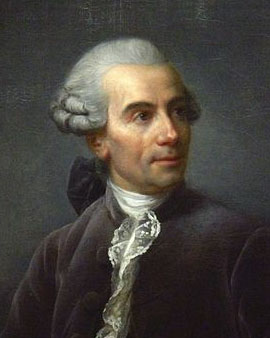The works of the painter Clause Joseph Vernet, born in Avignon in 1714, mostly show harbour and seafaring motives. These motifs were in great demand in the 18th century. But the peculiarity of the style of the artist is the panorama-like representation in which the horizon is low and the sky is very wide. This gives the pictures a very realistic effect, which is further enhanced by the intensity of the colours and the great appreciation of light and shadow.
The career of Claude Joseph Vernet was promoted at a very early age by his father, who was himself known as a decorating painter. He sent his son to experienced painters and enabled him to travel to the capitals of artistic creation at the time. After he had studied in Rome, among other places, he was called to the court of the French king to work for the state. Vernet was given the task of depicting the maritime power of France in his works. The artist had the claim to produce his works particularly truthful. Thus, scenes of everyday life and the work of the workers are often found in his paintings. It is even said that Claude Joseph Vernet once had himself tied to the mast of a ship in a terrible storm in order to feel better about the adventurous and dangerous life at sea.
The most famous paintings are "Landscape with Castle Ruins" and "The Ports of France".
×





.jpg)
.jpg)
.jpg)
.jpg)
.jpg)
.jpg)
.jpg)
.jpg)
.jpg)
.jpg)
.jpg)
.jpg)
.jpg)
.jpg)
.jpg)
.jpg)
.jpg)
.jpg)
 - (MeisterDrucke-93876).jpg)
 - (MeisterDrucke-93876).jpg)
.jpg)
.jpg)
.jpg)
.jpg)
.jpg)
.jpg)
 and Jacques Philippe Le Bas (1707-83) 1767 (etching burin) - (MeisterDrucke-85137).jpg)
 and Jacques Philippe Le Bas (1707-83) 1767 (etching burin) - (MeisterDrucke-85137).jpg)
.jpg)
.jpg)
.jpg)
.jpg)
.jpg)
.jpg)
_-_(MeisterDrucke-987989).jpg)
_-_(MeisterDrucke-987989).jpg)
.jpg)
.jpg)
.jpg)
.jpg)
.jpg)
.jpg)
_-_(MeisterDrucke-1014542).jpg)
_-_(MeisterDrucke-1014542).jpg)
.jpg)
.jpg)
.jpg)
.jpg)
.jpg)
.jpg)
.jpg)
.jpg)
.jpg)
.jpg)
.jpg)
.jpg)
.jpg)
.jpg)
.jpg)
.jpg)
.jpg)
.jpg)
.jpg)
.jpg)
.jpg)
.jpg)
.jpg)
.jpg)
_-_(MeisterDrucke-1656308).jpg)
_-_(MeisterDrucke-1656308).jpg)
_18t_-_(MeisterDrucke-982146).jpg)
_18t_-_(MeisterDrucke-982146).jpg)
.jpg)
.jpg)
_1762_Paris_-_(MeisterDrucke-1021603).jpg)
_1762_Paris_-_(MeisterDrucke-1021603).jpg)
.jpg)
.jpg)
.jpg)
.jpg)
.jpg)
.jpg)
.jpg)
.jpg)
.jpg)
.jpg)
.jpg)
.jpg)
.jpg)
.jpg)
.jpg)
.jpg)
.jpg)
.jpg)
.jpg)
.jpg)
.jpg)
.jpg)
.jpg)
.jpg)
.jpg)
.jpg)
_18th_century_Paris_Mu_-_(MeisterDrucke-1021983).jpg)
_18th_century_Paris_Mu_-_(MeisterDrucke-1021983).jpg)
.jpg)
.jpg)
.jpg)
.jpg)
_-_(MeisterDrucke-961167).jpg)
_-_(MeisterDrucke-961167).jpg)
.jpg)
.jpg)
_-_(MeisterDrucke-697485).jpg)
_-_(MeisterDrucke-697485).jpg)
 - (MeisterDrucke-93831).jpg)
 - (MeisterDrucke-93831).jpg)
_-_(MeisterDrucke-1583769).jpg)
_-_(MeisterDrucke-1583769).jpg)
_-_(MeisterDrucke-881063).jpg)
_-_(MeisterDrucke-881063).jpg)
 and Jacques Philippe Le Bas (1707-83) 1767 (etching burin) - (MeisterDrucke-112462).jpg)
 and Jacques Philippe Le Bas (1707-83) 1767 (etching burin) - (MeisterDrucke-112462).jpg)
.jpg)
.jpg)
.jpg)
.jpg)
.jpg)
.jpg)
.jpg)
.jpg)
 1774 (see also 13025) - (MeisterDrucke-50170).jpg)
 1774 (see also 13025) - (MeisterDrucke-50170).jpg)
.jpg)
.jpg)
.jpg)
.jpg)
_18th_century_-_(MeisterDrucke-1022482).jpg)
_18th_century_-_(MeisterDrucke-1022482).jpg)
_18th_century_Pa_-_(MeisterDrucke-1004510).jpg)
_18th_century_Pa_-_(MeisterDrucke-1004510).jpg)
.jpg)
.jpg)
 - (MeisterDrucke-71549).jpg)
 - (MeisterDrucke-71549).jpg)
.jpg)
.jpg)
.jpg)
.jpg)
.jpg)
.jpg)
.jpg)
.jpg)
.jpg)
.jpg)
.jpg)
.jpg)
.jpg)
.jpg)
.jpg)
.jpg)
.jpg)
.jpg)
.jpg)
.jpg)
.jpg)
.jpg)
.jpg)
.jpg)
.jpg)
.jpg)
.jpg)
.jpg)
 and Jacques Philippe Le Bas (17 - (MeisterDrucke-73022).jpg)
 and Jacques Philippe Le Bas (17 - (MeisterDrucke-73022).jpg)
.jpg)
.jpg)
.jpg)
.jpg)
 - (MeisterDrucke-107905).jpg)
 - (MeisterDrucke-107905).jpg)
.jpg)
.jpg)
_-_(MeisterDrucke-1001995).jpg)
_-_(MeisterDrucke-1001995).jpg)
_1772_Sun_098x162_m_-_(MeisterDrucke-947041).jpg)
_1772_Sun_098x162_m_-_(MeisterDrucke-947041).jpg)
.jpg)
.jpg)
_1773_Sun_075x06_m_Rouen_Muse_-_(MeisterDrucke-1002915).jpg)
_1773_Sun_075x06_m_Rouen_Muse_-_(MeisterDrucke-1002915).jpg)
 and Jacques Philippe Le Bas (1707-83) - (MeisterDrucke-111140).jpg)
 and Jacques Philippe Le Bas (1707-83) - (MeisterDrucke-111140).jpg)
.jpg)
.jpg)
.jpg)
.jpg)
.jpg)
.jpg)
_-_(MeisterDrucke-1023617).jpg)
_-_(MeisterDrucke-1023617).jpg)






